| |
Ragtime is a musical style mainly pianistic that came from the “coon” songs and melodies at the end of 19th century XIX in the United States.
There is no doubt that the origin of the ragtime was in the Afro-American community of the United States. Scott Joplin himself wrote that “always we have had ragtime music in the United States; ever since the black race was here”. But where and how the ragtime was generated?
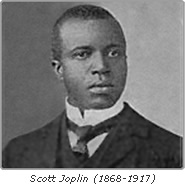 The novel “The autobiography of an ex-colored man” (1912) by James Weldon Johnson is very clear on the matter: The novel “The autobiography of an ex-colored man” (1912) by James Weldon Johnson is very clear on the matter:
Ragtime music “was originated in the places of doubtful reputation, around Memphis and Saint Louis by Negro piano players who knew no more of the theory of the universe, but were guided by natural musical instinct and talent. It made its way to Chicago, where it was a popular some time before it reached New York. These players often improvised crude and, at times, vulgar words to fit the melodies. This was the beginning of the ragtime song” or coon song.
The coon songs singers truly were at the same time black entertainers, who often were accompanied themselves by the banjo. An example of this song that have survived 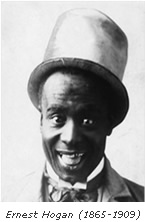 as the time passed are the songs “The Whistling coon” or “Laughing song” performed and recorded by George W. Johnson. The coon songs had in general coarse words and tasteless that sex or violence situations were described. They even reflected the mockery and the racism of the North American society of those days towards the black people, being indeed offensive for the performers. In any case, these songs locked up the purest essence of the Afro-American popular culture. as the time passed are the songs “The Whistling coon” or “Laughing song” performed and recorded by George W. Johnson. The coon songs had in general coarse words and tasteless that sex or violence situations were described. They even reflected the mockery and the racism of the North American society of those days towards the black people, being indeed offensive for the performers. In any case, these songs locked up the purest essence of the Afro-American popular culture.
Between 1880 and 1910 the coon songs caused much of sensation in the rest of the American society, that leaving to a side his traditional puritanism, were in demand for piano arrangements, become to be published several hundred a year. Perhaps the most influential coon song composer and probably the precursor of the ragtime style was Ernest Hogan (1865-1909), who as a musician of minstrel show and vaudeville, obtained a great success with the songs “Pas Ma La” (1895) and “All coons look alike to me” (1896).
All these entertainers were able to dance any kind of rhythm as march, two step, polka or cakewalk. The last one was a typical Afro-American dance in which were included passages or humorous provide sections of improvising steps dance consisted of which the couple danced slightly inclined 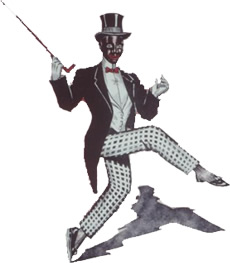 backwards taken by the hand and raising solemnly raising the legs to rate of the support, giving (tap dances generally), being awarded with a cake couple of dancers who more steps complexity and skill showed. The women dressed elegant dresses and carried in their left hand a luxury umbrella and the men black elegant tuxedo (called of contemptuous form “darky dandies”) and carried as well in their right hand a cane. One of the very first published cakewalk had as a title “At to Georgia camp meeting” by Kerry Mills, published in 1897. The cakewalk, although danced in the countryside, showed the elegance and the exquisite against rough manners of the songs coon. backwards taken by the hand and raising solemnly raising the legs to rate of the support, giving (tap dances generally), being awarded with a cake couple of dancers who more steps complexity and skill showed. The women dressed elegant dresses and carried in their left hand a luxury umbrella and the men black elegant tuxedo (called of contemptuous form “darky dandies”) and carried as well in their right hand a cane. One of the very first published cakewalk had as a title “At to Georgia camp meeting” by Kerry Mills, published in 1897. The cakewalk, although danced in the countryside, showed the elegance and the exquisite against rough manners of the songs coon.
Other traditional dances or rhythms of the black community at the end of the 19th century were the stoptime, the slow drag and the rag two step. 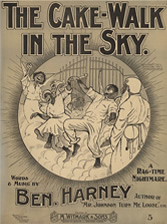
In the last quarter of the 19th century these popular and catchy coon melodies were orchestrated as ballroom music by the most important “white musicians” orchestras, being attractive combination to touch to rate of march those melodies that introduced likeable jumping or syncopated notes, as Victor Dance Orchestra did, obtaining the best success with “Cake-Walk in the Sky” (1899) by Benjamin Robertson “Ben” Harney (1872-1938), recorded in 1905 or “Patrol Comique” by (1886) by Thomas Hindley, recorded later, in the twenties.
Without they noticed, the ballroom orchestras of Paul Whiteman, Irving Berlin and Victor Herbert will be the first orchestras of ragtime and the first one of jazz too. Well, they something knew about it, because Paul Whiteman had not doubt in named himself like “the inventor of the jazz”.
All these dances will contribute later, as of 1920, to the appearance of foxtrot, dance that had a wider social acceptance, mainly when smoothing their melodies and breaking contact themselves with the previous rates, of the same form that the jazz would absorb to ragtime at the same age.
In 1905 ragtime was already a fashionable music that caused rage from coast to cost of the United States by his melodic enchantment and his kind of rhythmic impact that forced the public to take the beat with the foot.
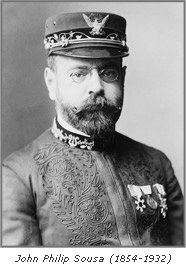 It was so the fever of “ragging” or the effect to turn into ragtime any melody, that the famous band of John Philip Sousa did have no doubt in including as an encore of the marches in the program some of these “coon ballads” properly orchestrated by the trombonist Arthur Pryor. Something similar to the transformation that was made when the New Orleans bands turn on the choral church anthems into instrumental funeral marches on the street. It was so the fever of “ragging” or the effect to turn into ragtime any melody, that the famous band of John Philip Sousa did have no doubt in including as an encore of the marches in the program some of these “coon ballads” properly orchestrated by the trombonist Arthur Pryor. Something similar to the transformation that was made when the New Orleans bands turn on the choral church anthems into instrumental funeral marches on the street.
But the main way of propagation of the ragtime style was through the pianola rolls that composers and pianists, most of them black musicians, recorded it for the game saloons and brothels of all United States. Shortly after the edition in score of piano of those rags for band will begin, motivating as well the development than we will call later the classic ragtime, as a certain piano style. At that time the main group of publishing houses and composers of ragtime begun to be well-known under the name of Tin Pan Alley, and from the beginning was specialized in the publication of coon songs. 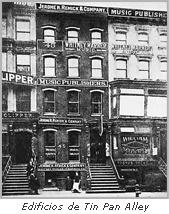
The Tin Pan Alley was located in a group of buildings at 24th street, between the Sixth and Broadway, in the city of New York. The main publisher of all of them was the company Jerome H. Remick & Co. being its publishing manager, Charles N. Daniel (1878-1943), who had the honor of being the person in charge of the very first Scott Joplin ragtime ever published: Original Rags, in December 1898. Among the most important song composers in Tin Pan Alley was Irving Berlin (1888-1989), who published in 1909 rags the popular song “That Mesmerizing Mendelssohn” in ragtime tongue, using the famous melody of Song of Spring by the German composer.
“Missisippi Rag” by William Krell (1868-1933) had been the very first ragtime for piano published (1897), in whose cover specified that it was “the first ragtime written and played by the composer’s orchestra in Chicago”.
Indeed the celebration of the Chicago World Exhibition in 1893 attracted many musicians, dancers (minstrels) pianists and traveling singers from the south of the United States, where the coon songs and the rags became popular as an unofficial form.
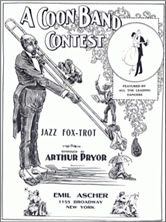 Probably among them was Brn Harney, author of the first Instructional Ragtime (published in 1897), a method to practice the style on popular coon songs. Probably among them was Brn Harney, author of the first Instructional Ragtime (published in 1897), a method to practice the style on popular coon songs.
Orchestras like the one of Arthur Pryor (that left the trombone solist position in the John Philip Sousa orchestra), went to play the well-known and demanded marches, valses, schottisch and polkas to play coon melodies or rag-times properly orchestrated. One of the most characteristic ragtime of this period of time was the cakewalk titled “The coon band contest” 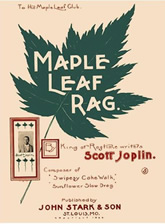 recorded in 1905 and the march titled “The Minstrel Band” recorded in 1910 for Victor. Also in 1910 the classic “Maple Leaf Rag” by Joplin played by Vess Ossman at the banjo accompanied by his orchestra was recorded, setting this instrument, along with the piano, the most appropriate to perform ragtime. That the banjo was included in the first jazz bands was not by chance, without a doubt it was for its bond with the ragtime. In fact in the minstrels shows, the banjo was the unique instrument that could compete with the piano in the challenge of play all those evil syncopations. In addition the piano was an instrument reserved to the premises and halls, while the banjo was more useful for traveling musicians. recorded in 1905 and the march titled “The Minstrel Band” recorded in 1910 for Victor. Also in 1910 the classic “Maple Leaf Rag” by Joplin played by Vess Ossman at the banjo accompanied by his orchestra was recorded, setting this instrument, along with the piano, the most appropriate to perform ragtime. That the banjo was included in the first jazz bands was not by chance, without a doubt it was for its bond with the ragtime. In fact in the minstrels shows, the banjo was the unique instrument that could compete with the piano in the challenge of play all those evil syncopations. In addition the piano was an instrument reserved to the premises and halls, while the banjo was more useful for traveling musicians.
It is not difficult to notice that ragtime pianists continued evolving in their style to become the jazz pianists. Probably the best example of this metamorphosis or rather symbiosis we find it compositions like “Climax Rag” by 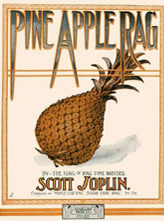 James Scott performed by the pianist Jelly Roll Morton (1885-1941) and his orchestra. James Scott performed by the pianist Jelly Roll Morton (1885-1941) and his orchestra.
On the other hand is not either difficult to find explicit elements of jazz in the last section of “Pine Apple rag” by Scott Joplin.
But which is the characteristic that defines the ragtime music?
In brief I could say that ragtime consists in the combination of a series of assembled syncopated melodies on a strict rythmical double step acompaniament (called stride). Under the formal point of view, ragtime is formed by three or four sections of 16 bars each. “Dill Pickles” (1906) 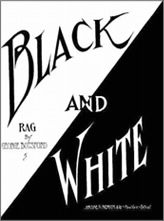 by Charles Leslie L. Johnsons (1876-1950) and “Black and White Rag” (1908) by George Botsford (1874-1949), offered one of the first formal pattern of ragtime. Tom Turpin and Charles Hunter could also be named between the most important impellers of the classical ragtime, like the usual collaborators of Joplin: Louis Chauvin, Arthur Marshal and James Scott. by Charles Leslie L. Johnsons (1876-1950) and “Black and White Rag” (1908) by George Botsford (1874-1949), offered one of the first formal pattern of ragtime. Tom Turpin and Charles Hunter could also be named between the most important impellers of the classical ragtime, like the usual collaborators of Joplin: Louis Chauvin, Arthur Marshal and James Scott.
In Afro-American dialect, the slang, the verb to rag or ragging means to extend or to drag notes of a melody played by the right hand until make them crossed or syncopated with the bass acompaniament played by the right hand. That is like to say that the verb to rag, would be equivalent to say “to sincopate”. “Ragging the scale” of Arthur B Claypool is a good example of how a simple musical scale is turned into a ragtime scale. Therefore, the fundament of the ragtime style is not its characteristic rate of support, nor either its attractive syncopated melodies, but the combination of these two characteristics simultaneously.
Already the prodigious colored pianist John William “Blind” Boone (1864-1927), and his predecessor and teacher, also blind,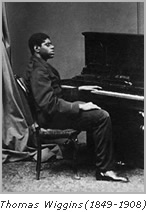 Thomas Wiggins, were looking for the effect of the “ragging time” in their compositions using melodies of strong traditional flavor inspired by Afro-American songs and tunes. The piano rolls that recorded Boone in 1912 in Chicago (first of its kind that were recorded in the United States) therefore reflects it. These rhythmic and melodic elements also are picked up with great fidelity by the composer and virtuoso pianist Louis Moreau Gottschalk Thomas Wiggins, were looking for the effect of the “ragging time” in their compositions using melodies of strong traditional flavor inspired by Afro-American songs and tunes. The piano rolls that recorded Boone in 1912 in Chicago (first of its kind that were recorded in the United States) therefore reflects it. These rhythmic and melodic elements also are picked up with great fidelity by the composer and virtuoso pianist Louis Moreau Gottschalk 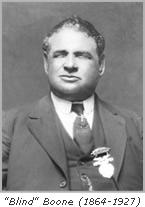 (1829-1869), as he did with several popular Afro-American melodies like “The banjo” (1852). (1829-1869), as he did with several popular Afro-American melodies like “The banjo” (1852).
The combination of the melodic exotism with the pitch academicism of the acompaniament, was a common futures in the later “stride” colores pianists, like James P. Johnson, Willie “The Lion” Smith or Thomas “Fats” Waller.
Those characteristics were those that took the ragtime style to the popularity, something that was profiteer by other generation of pianist-composers, they who knew very well that including the word rag or ragtime in its compositions title, already secured them an important part of the success. I mention as an example of them the popular “Alexander Ragtime Band” (1911) or the later “Bugle Call Rag” (1922), whose original title was “Bugle Call Blues”; pieces the most they had about ragtime was the title. Others at least kept the spirit of the ragtime, as is the case of “Charleston Rag” (1917) by James “Eubie” Blake, whose original title was “Sounds of Africa”. Therefore, I could say that from 1913-1915 a process of “contamination” or “despoliation” of the fundamental futures of the classic ragtime begins.
A renewed interest for the ragtime would arise again around the year 1970, that meant not only an enthusiastic and nostalgic trip to the past, but in addition, a recognition to those colored composers who were able to find a artistic language that expressed the essence of the African music and culture, which was “transplanted” and evolved in another geographic scenenary - imposed and inherited by the slavery- and attracted the attention and the esteem of all the western intellectuality from then to the present days
|
|
Ragtime Concert Band
Founded in the 80 in Murcia (Spain) based on original arrangements that made for a formation composed by flute-piccolo, clarinet, trumpet, trombone, tuba, piano and drums, becoming one of the first European instrumental groups specializing in ragtime. |
| Read more |
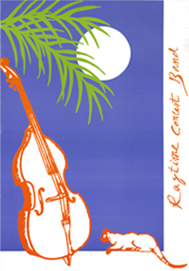 |
|
|

